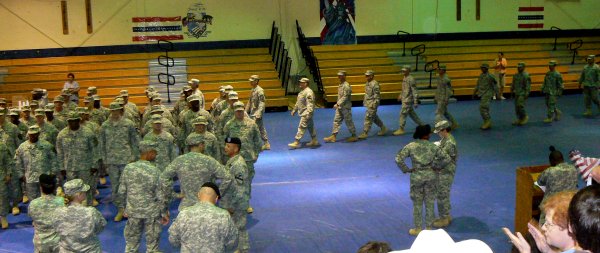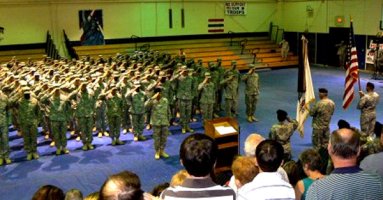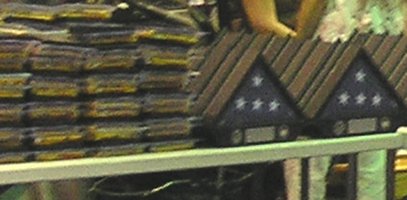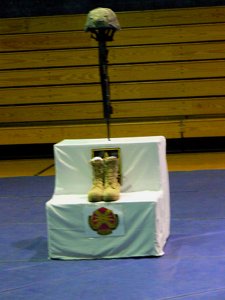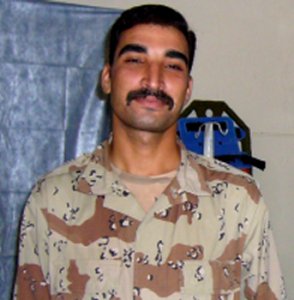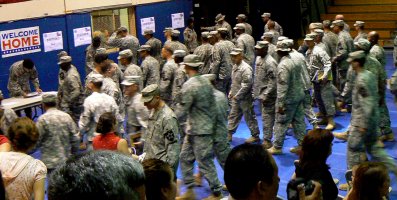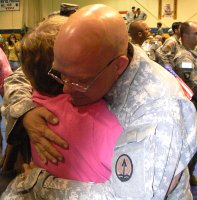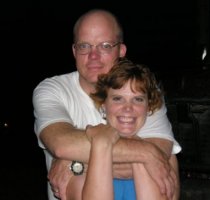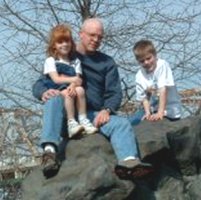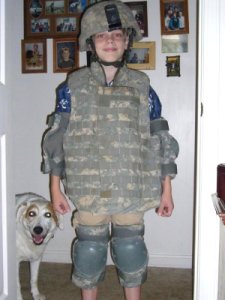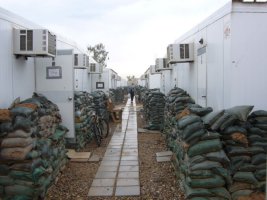Our Soldier in Iraq
On June 12, 2007 at about 3am central time, the 3-3-5 Military Transition Team arrived back at Ft. Hood after one year of service in Iraq in support of an Iraqi Army infantry battalion.
The teams were made up mostly for an Army Reserve group but with about 30% soldiers from the Regular Army, mostly career soldiers. As with all things military, the first activity, once the soldiers had checked in weapons at the armory, was an assembly. As with most things Reserve, that assembly was full of false starts and disorganization, but it did at last happen!
Also like many military events this was drug on and on while senior officers each got a chance to speak and to give recognition to the members of the Reserve, while the soldiers of the Regular Army had to stand in formation, totally ignored. The Reserve general hardly gave notice to the service of those who were real soldiers. In fact, they were so unconcerned about the Regulars that none of their families were ever given any support from the unit command and we even had great difficulty in getting any information about when or where the troops would return! It was discovered that not one member of the Active Army were even on the support list. It was with the help of the staff at Senator Kay Bailey-Hutchinson's office that we were even able to make contact with the proper people. And when we did make contact, it was discovered that no active duty soldier's name was even on the list of returning troops that the command office was using. To determine what flight Ken would be on, I had to give the Captain in public relations the names of some of the Reservists that I knew were part of his team. As happy as we were that our son was returning from Iraq, I remain very angry about the shabby way that all of them were treated. Notice also, among all of the neat gifts for Reservists only is a burial flag for each soldier of the unit? Strange gift for a returning combat veteran.
As is proper at any military return ceremony, just after the playing of the national anthem, recognition was given to those who were lost in action in the year of deployment. Fortunately, for this group there were no members of the teams lost but there were some support personnel. There were some injuries due to hostile actions, among them was one member of Team Buffalo, SFC Rodriguez. Fortunately, "Rod" has now recovered from his wounds. He was returned to the states for recuperation prior to the unit's return and was not present for the ceremony.
At long last the "dismissed" command is given and troops can greet families and start the process of leaving to return home. Since the soldiers came from other parts of the country to join the teams, only a few families were there to greet them. We were fortunate to be able to stay in Texas to greet our soldier but his wife and children were waiting at Ft. Knox for his arrival there. Nearly two more days passed before Ken got to join them again.
Will this be the next soldier that our family waits nervously for his return?
One final footnote. After returning to his command at Ft. Knox our son was awarded the Combat Medic Badge for caring for wounded soldiers, risking his own safety while under enemy fire.
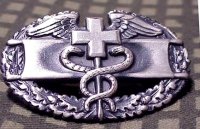
Here are some of the latest pictures that Ken has sent from his station in Iraq. All bold print is quoted from Ken's email.
In early May, Team Buffalo suffered their first casualty, SFC David Rodriquez. Rod, Ken's closest friend in Iraq, was with an Iraqi patrol when he was injured by a "local control" IED. Such devices are controlled by a hidden terrorist with a trigger device and a wire leading to the device. The idea is to wait for the IA soldiers to pass and thus to get the American. Rod suffered a broken leg and some other injuries including to the face from flying gravel and dirt. He was evacuated first to Germany and then to Ft. Sam Houston, where he is recovering. Fortunately, he is expected to fully recover and return to duty, however he will not be returning to Iraq to rejoin the team.
The first shot is one of Ken with the First Sergeant of the IA troops that he works with. Ken is wearing his "blast glasses" which are worn at any time he is outside of the compound. He has another name for them, but this is a public website! As one can easily tell from these pictures, he is very popular with the IA soldiers and officers as well. The third picture shows Ken at work doing emergency field medical training for the troops.
*The second picture* was taken during a mission of myself and two of our interpreters. They happen to be the two I like the best. The team has 5 total, 4 local Iraqis (all from a village about 45 minutes from the base) and one a US contractor from the US. Those two are brothers. I've never pursued it further, but most of the terps learned English in school. I've always been curious if they attended school more than the average, are they a bit more "well-to-do" as if English is taught in school, why more Iraqis don't speak it, plus is that the country as a whole has a 50-60% illiteracy rate. I've always been curious why they all attended school, but the majority of the country didn't.

*Dinner* was taken in the Iraqi mess hall. Usually their meals consist of some kind of boiled meat, this time fish, rice and bread. Yes the red in the back pail is from blood. That is usually reduced and some seasonings added and served as a broth/soup. It's very plain, but not bad tasting, yes I've eaten with them. Of course as you can guess by the picture, you always run the risk of getting sick because of lack of sanitation. Nobody from the team has gotten sick, but there have been times 40 of the IA have gotten sick the same day because of lack of sanitation. This is just the way of the Iraqis, at least outside of the cities. The first picture is from an IA field kitchen. Most of their cooking is done with wood or charcoal and looks more like an army from a century ago.
*Down Town*, *HMMWVs, IA HMMWV *and* US Troops* were all taken during a recent mission, part of the "Clear and Hold" strategy in this area. We ended up building a patrol base overlooking a bridge believed to be a major route for insurgents. It's just different troops kind of contrasting the differences between the US and the IA, plus a look of another village in this area.
The next two pictures are of IA weapons training. Ken reports that such training is a weak area of the Iraqi's. He says that they just don't do much real training and seldom work very hard at it when they do. In the first picture they are training on use of a Russian made, machine gun and in the second on firing an RPG (rocket propelled grenade). The last is a shot of a US F-16 outside of a shelter on a former Iraqi base.
*#1* is a picture taken in the IA Battalion Headquarters of a weapons cache found by the IA. They are very likely to pick them up and bring them back to the base after they find them. The US generally blows them in place, or at least in the area. I will be sending some pictures of a cache being removed from it's location later, I have to get the picture from a buddy. It's kind of interesting, the weapons cache has kind of become the "body count" from Vietnam. It's almost a tool used to "keep score" and judge the success of a mission. The second and third shots are from a wrestling match between a US soldier and an Iraqi. Wrestling is a very common recreation among the Iraqi troops and seems to be almost a national pass-time. Even though the US troops tend to be much better conditioned, it is rare for one to win a wrestling match with the Iraqi's.

*Wrong on many lvls* - This was taken during a recent mission. The title comes from the fact we can play a game of "What's wrong with this picture" with it. The Soldier is a Major on the team (who a few days prior was attempting to convince me of his infantry prowess - he's infantry by branch. If you notice, he doesn't have a weapon, but wait, his M4, with a grenade launcher attached IS in the picture, in the hands of the interpreter, who by policy isn't supposed to be armed (most are though). Guess he missed the training part about not surrendering your weapon. And this my friends and readers, demonstrates just one of the problems that we have when we use so many part-time soldiers in positions of command and the added danger to our professional soldiers when they are put under the command of one.
The last two shots are from a dust storm that took place where they are stationed recently, and the sunset following it. It is a unique part of the world. This may well be the last installment of the combat part of the "Team Buffalo" story, as they now have been told that they will be leaving Iraq for Kuwait and debriefing on June 4, and the target date to fly back to Ft. Hood for processing is June 8.
Next Page
Here are some of the latest pictures that Ken has sent from his station in Iraq. All bold print is quoted from Ken's email.
Tower 10 - This is a photo out of one of the Iraqi guard towers (#10) about 150 meters from our team house. You can't really tell in that picture, but you are about 30 feet off the ground.
Along the Wall - Also taken from that guard tower, just looking along the wall of the base in either direction.
Dali Abas - This is a photo of the Iraqi Army compound in Dali Abas. The Battalion has one company stationed there and it's about 30 minutes from the base. The armored vehicle you see is a former American vehicle (repaired after scavenged from the bone yard) that the Iraqis used on missions. It was hit by an IED and had the left front drive sprocket and road wheel blown off. A funny thing about those vehicles, the Iraqis feel safer from IED blasts in them, but because of advancements in metallurgy (they where made in the 60's) the thinner armor of the HMMV is actually better. but they make them feel safer and sometimes that's what matters.
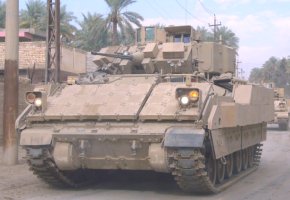

- This picture of a Bradley Fighting Vehicle was taken during the most recent large mission. The current unit here, 6-9 Cavalry, 1st
Cavalry Division, is using the Bradleys far more than the previous two units, I'm unsure why, other than they are much safer in an IED blast.
Iraqis on mission - nothing special, just some of the Iraqi Army during that mission.
A very dangerous place to be!
The last of the pictures are in sequence and show bit of the threat and what EOD does here. On that mission we located about 10-15 IEDs and several caches. The majority of the IEDs where driven past by some, or the majority of the vehicles, but for whatever reason were not detonated by "the bad guys" One of them, that was found as troops started searching the buildings around our immediate area was about 60 meters behind where I was parked, so I ended up with front row seats of what happens next. Well, front row, looking through bulletproof glass and through a rear view mirror.
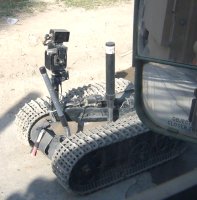



Robot and robot up close are pictures of one of the robots EOD uses to examine explosives from a safe distance and carry charges down to blow them up.
Driving the robot - this is the EOD tech (Air Force, that's why the different uniform, but there's also both Marine and Army EOD) driving the robot by remote control. MAJ D, one of the team, is watching over his shoulder. (click on the picture to see the Major)
The rest of the photos where taken through the side mirror or out the turret by the gunner.
Going to look 1 and 2(click on picture to see 2) and looking are the robot on it's way down to take a look at the IED and to place the charge to blow it up. In the first two, the yellow can you see is sitting right beside it. The can was placed there by the troops that found it as an easy way of identifying where it was. In Going to look you can see a green wire on the ground on the side of the mirror. That's the wire connecting the explosive charge to the detonator used to blow it up.
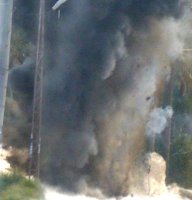



BOOM - 1 pound of C-4 plastic explosive and a 155 mm artillery shell make quite an explosion.
After blowing up the round, EOD drove the robot down to look again and verify that the round was destroyed. Well two things happened, first, there was another 155 mm round in the hole. The first charge on blew the top round, and the IED was composed of two rounds. Second, the driver got too close to the hole and the robot toppled over into the hole, with the IED in it. Well, EOD had to drive down and rescue their robot and that's what the last pictures are of. Remember, there is still a live 155 mm artillery round in that hole, under the robot. After rescuing the robot, they place another pound of C-4 on it, with a timed fuse.
So now you know what the #1 threat to our troops is while serving in Iraq. And the guy who helped out the robot? Now there is a man with guts! Unfortunately, I do not know his name to give him credit for what he does.
And this was the result of an Iraqi armored Land Rover that hit an IED.
The driver was killed and one other occupant died 2 days later. He was made worse (head injury) because of the Iraqi attitude about wearing helmets. He probably didn't have it one (or the chin strap snapped anyway). There was another casualty that didn't either. The other 4 people in the vehicle where sent to the American Combat Support Hospital.
In the first picture Ken is treating an Iraqi soldier who has been injured, and instructing the Iraqi medical personnel. In the next we see two of the members of Team Buffalo in a period of just "goofing off" while on base in a secure area. The last picture shows that even our troops need a break for Christmas.
Next Page
This map shows where Team Buffalo is stationed. It is a base that is for the Iraqi Army with one the US Army battalion. To the right of their location is the border with Iran.
"Republican Guard Logo painted on one of the hatches of the vehicles in the bone yard here. It's kind of curious that the vehicle is there, as most of the equipment is captured Iranian equipment from the Iran Iraq war. There is some old American equipment there, provided to the Shah when he was in power."
The second picture is of the US Army aid station on the base, to contrast with that posted earlier of the one for the Iraqi army. In the third picture is the latest in HMMV equipment.
"HMMV upgrade - this is my vehicle. Amazingly we were two of the first ten vehicles in the country to get the latest and greatest armor upgrades for the HMMV. The side armor, the majority of the threat direction is about twice as thick as before. Of course it comes at a cost, the doors now weigh about 500 pounds each and it further overloaded the vehicle. As loaded when rolling on missions it now weighs over 15,000 pounds, the maximum gross vehicle rating for the HMMV is 12,200 lbs."
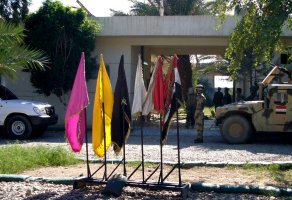
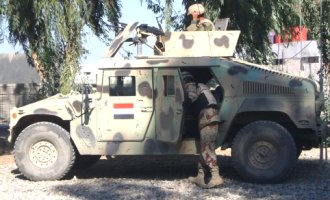
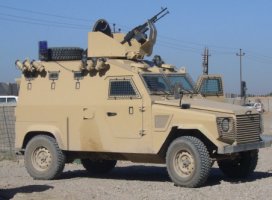
"I took this picture of the Iraqi Headquarters building. The flags represent the five companies in the Battalion."
"This is an Iraqi Army HMMV. Yes, it's the same as the American, either provided by us, or possibly bought by the Iraqi government, right off the factory floor. The battalion has 14 of them. The camouflage pattern is the same as the original American Dessert cammo pattern, seen mostly during Dessert Storm. We never painted our vehicles that way though, just sand."
"IA Land Rover - These are the other armored vehicles the Iraqis have. They are made under license in Turkey. According to the book, the armor
will stop a 7.62 mm bullet (.30 caliber), but since they are significantly lighter than our doors, I wouldn't want to test it."
"LSAA Housing - During my most recent trip to Logistic Support Area Anaconda (I believe the largest base in Iraq) I took this picture of how
"the other half" lives. These are the trailers that house the majority of Soldiers in Iraq. Each room is for two Soldiers, I'm not sure exactly how big the rooms are. The sand bags are incase of a mortar attack, it gives something for people inside to hide behind. Rarely do mortar rounds come in that we (the American Forces) don't know at least a few seconds before impact - the advantages of ground surveillance radar. We also attempt to shoot back. In a couple of places at Anaconda there are Phalanx gun systems - look to be the same as on naval ships. I'm guessing to shoot the mortar rounds down, since it was designed to shoot down missiles before they impact ships."
I want to add one additional thought of my own to this new page. If you want to know a lot more about what Ken and Team Buffalo are dealing with, and what seems to me to present a pretty accurate picture of what is happening there, see if you can locate a copy of the Oct. 18 issue of the "Wall Street Journal." In an article written by Greg Jaffe there are a number of quotes from members of the team which this team replaced at the duty station where Team Buffalo now serve. The story is titled "Problems Afflict US Army Program To Advise Iraqis." The newest team to arrive on the base where Ken is stationed is made up of "Regular Army" so it does seem that things are changing, or at least beginning to. Team Buffalo was one of the last teams to be trained prior to the First Infantry Division taking responsibility for this transition program and the training was moved from Ft. Hood to Ft. Riley.


